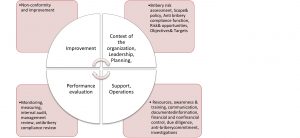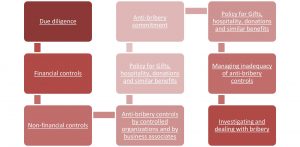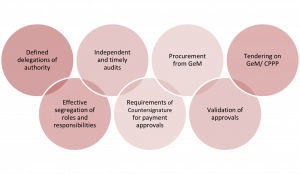

Bribery a Significant Impediment to Socio-Economic Progress: Global prospective
Bribery is a pervasive problem that transcends borders and can said to be the most widespread and predominant white-collar crime. Despite all this, some argue that it’s often justified with statements like “it’s inevitable,” “everyone does it,” “it’s the cost of doing business,” “it doesn’t matter,” and “nobody gets hurt.” But is this really the case?
The fact is Bribery is far from a victimless crime; it gives rise to significant social, moral, economic, and political issues. Its detrimental effects are multifaceted, manifesting in various ways which significantly hinders socio-economic development in both developed and developing countries. Bribery not only compromises the integrity of justice systems, but also threatens human rights, introduces instability into business transactions, inflates the cost of goods and services, diminishes the quality of products and services, and disrupts the equitable functioning of markets. Additionally, this unlawful conduct increases the financial burdens on businesses and erodes trust in institutions. Furthermore, it can lead to the introduction of substandard and unsafe products into the market, potentially endangering lives, and property.
Governments are continuously advancing their efforts to tackle bribery through both National and International legal frameworks. However, can laws and regulations alone be considered adequate for solving this issue? Shouldn’t organizations and society also shoulder some responsibility in the fight against bribery.
Bribery Challenges: The State of Bribery in India
Although India has stringent anti-corruption laws, corruption and bribery remain prevalent issues in the country. In recent years, there has been a concerning rise in public discontentment regarding these problems. High-profile cases of corruption, often linked to bribery, have emerged as significant political concerns.
Ernst & Young LLP conducted a survey on bribery and corruption, involving respondents from diverse Indian enterprises, including the banking and financial sectors, media and entertainment, and manufacturing sectors. The survey revealed that industries such as infrastructure and real estate, mining and metals, aerospace and defence, and power sectors are particularly susceptible to corruption. The report emphasizes that approximately 89 percent of the respondents believed that stricter law enforcement is urgently required to combat the widespread issue of bribery and corruption
While the covert nature of bribery makes it challenging to determine precise financial losses attributed to it, did you know that, according to the World Bank, approximately USD 1.5 trillion is paid in bribes worldwide annually? Additionally, the World Bank estimates that corruption, including bribery, results in a loss of approximately 0.5% of India’s gross domestic product (GDP), amounting to INR 365 billion, each year.
Unveiling the Indian Landscape: Laws and Strategies for Preventing Bribery
It’s crucial to acknowledge that interaction between the government and government-owned enterprises is inevitable for businesses operating in India. Given the significant discretion held by government personnel, various laws and regulations have been introduced to combat bribery and corruption. These include the Prevention of Corruption Act 1988, Foreign Contribution Regulations Act 2010 (FCRA), Right to Information Act 2005 (RTI), Central Vigilance Commission Act 2003 (CVC), Lokpal and Lokayuktas Act 2013, Companies Act 2013, Prevention of Money Laundering Act 2002 (PMLA), Black Money Act 2015 (BMA), Whistleblowing Act 2011 (WBA), and SEBIs LODR Regulations among others.
Existing Regulatory Mechanism for investigation of Bribery and Corruption cases in India
The Prevention of Corruption Act 1988 is the law governing bribery and corruption in India and is only applicable to public servants. At the state level, every state has a Vigilance Department (VD) and Criminal Investigation Department (CID) for investigating cases registered at police stations.
On the National level, the principal investigative agency is the Central Bureau of Investigation (CBI), responsible for coordinating various vigilance departments. Additionally, the Central Vigilance Commission (CVC) operates as an independent body with the authority to oversee all vigilance efforts within the Central Government of India, encompassing planning, execution, review, and reform of vigilance work.
While the new Prevention of Corruption Act (PCA) has indeed introduced a legal framework for imposing fines and potential prison sentences of up to seven years on offenders, but often the practical enforcement of these penalties still is infrequent.
IS/ISO 37001: 2016 Anti-bribery Management System (ABMS): Genesis
For the first time, with an aim to help the organization in designing and implementing reasonable and proportionate measures to prevent, detect and respond to bribery, an internationally recognized common framework focussing on anti-bribery compliance has been developed as IS/ISO 37001 Anti-bribery management system – Requirements with Guidance for use.
IS/ISO 37001 builds on several requirements that represent globally recognized good practices for anti-bribery and guidance from various international organizations, such as the International Chamber of Commerce, Organization for Economic Cooperation and Development, Transparency International and various governments representing a global consensus on anti-bribery aspects. The checks and controls highlighted in IS/ISO 37001 gels well with the guidance already issued by Central Vigilance Commission (CVC) for public authorities in India.
The Anti-bribery management system aims to foster a culture of honesty, transparency, and compliance within an organization. The organization’s culture plays a crucial role in the success of this system. A well-managed organization should have top management support for a compliance policy and adequate resources to meet legal obligations with integrity. This anti-bribery policy and management system not only help prevent or mitigate the costs and risks associated with bribery but also build trust and a positive reputation in business transactions.
Bribery risks can vary based on an organization’s size, geographic locations, sectors, and the complexity of its activities. The Anti-Bribery Management System (ABMS) provides a framework for implementing policies, procedures, and controls that are proportionate to the bribery risks faced by the organization.
IS/ISO 37001: 2016 Global Benchmark for improving Anti-bribery efforts.
In addition to reducing bribery risks and financial losses, IS/ISO 37001 offers several other benefits to organizations. It provides national and international recognition for their anti-bribery efforts, giving them a competitive edge. The implementation of an Anti-Bribery Management System (ABMS) sets a global standard for organizations to assess, enhance, or establish their own anti-bribery programs. This installs confidence in stakeholders, including customers, suppliers, and shareholders, that the organization adheres to international ethical business standards. As a result, IS/ISO 37001 is particularly advantageous for organizations operating globally and may eventually become a requirement for those engaging in international partnerships.
ABMS Framework: Starting with the basic
The standard requires organizations to take a series of measures, proportionate to their circumstances, to prevent, detect and address bribery by following a Plan-Do-Check-Act (PDCA) approach towards the continual improvement of its Anti Bribery system.

Identifying Gaps in the system
Organisations aiming to embark a journey to implement IS/ISO 37001 are recommended to follow, among other things, the following foundational list of anti-bribery checks and controls, for sensitive activity/ positions:

Most of listed organizations are already putting into action such checks and controls, as mentioned below, as a sound operational approach to uphold uniformity, consistency, and transparency while striving to achieve their objectives.

Enhancing both financial and non-financial oversight, alongside the implementation of automated monitoring tools to prevent unauthorized payments, can enhance an organization’s financial well-being, reputation, and opportunities for growth and success. This showcases the organization’s commitment to conducting ethical business practices for its stakeholders.
ABMS: A tool for Value Chain.
Not only ABMS has the potential to assist organisations in combating bribery risk within their own operations but also throughout their global value chains.
IS/ISO 37001 is a powerful and flexible tool, which can be adapted to the size and nature of any organization and the bribery risk it faces. It also offers the opportunity for the implementing organisation to extend its compliance to its business associates in value chain, while doing its business and strengthening its anti-bribery culture.
ABMS in Action: United for Ethical Business
After understanding and implementing IS/ISO 37001: 2016, third party certification from an independent and accredited Certification Body is all organisations need to do to display that the organisation is doing everything they reasonably can, to reduce bribery.
This means that an independent and accredited third party will perform a rigorous analysis of the anti-bribery programme and specific requirements of this standard and can certify an organisation based on their anti-bribery performance.
In a brief period, IS/ISO 37001 is gaining recognition as an effective tool in the battle against bribery. Businesses and governments are enthusiastically adopting it within their operations and global value chains. It is evident that leadership commitment and active implementation of ABMS pose the primary challenge for any organization and are the crucial elements for successful anti-bribery management programs. IS/ISO 37001 provides organizations with a toolbox to address this challenge, but its effectiveness ultimately depends on genuine action and intent.
The Bureau of Indian Standards (BIS) is the only Government body in India which is operating various Management systems since 1991 with its large pool of experienced auditors. In its endeavour to provide credible system certification, BIS has successfully certified various big Organisations for their ABMS performance. For seeking Certification to IS/ISO 37001: 2016 from BIS, organisations can contact mscd@bis.gov.in.
References:
1. Bribery and corruption: Ground reality in India- A survey by Fraud investigation & Dispute Services by Ernst & Young
2. Bribery and Corruption Laws in India, 2023 – Global Legal Insights
3. UICIFD briefing paper, the current state of India’s Anti-Corruption Reforms: The RTI and PC 2010
4. IS/ISO 37001:2016 Anti Bribery Management Systems- Requirement and Guidance for use.

Mrs Shalu Varshney
Scientist D | Joint Director, Bureau of Indian Standards
(shaluk@bis.gov.in)